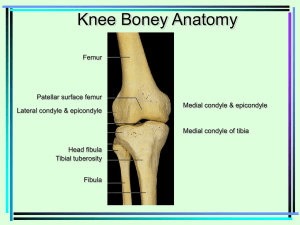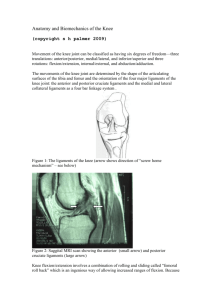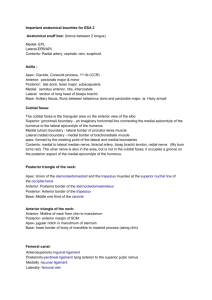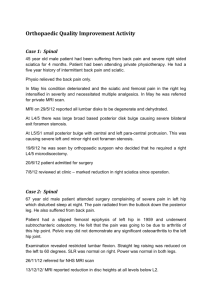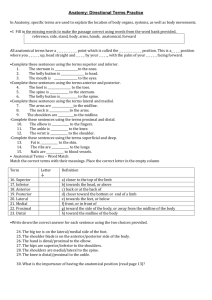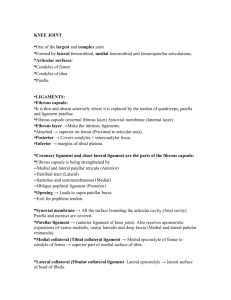Knee and leg - WordPress.com
advertisement
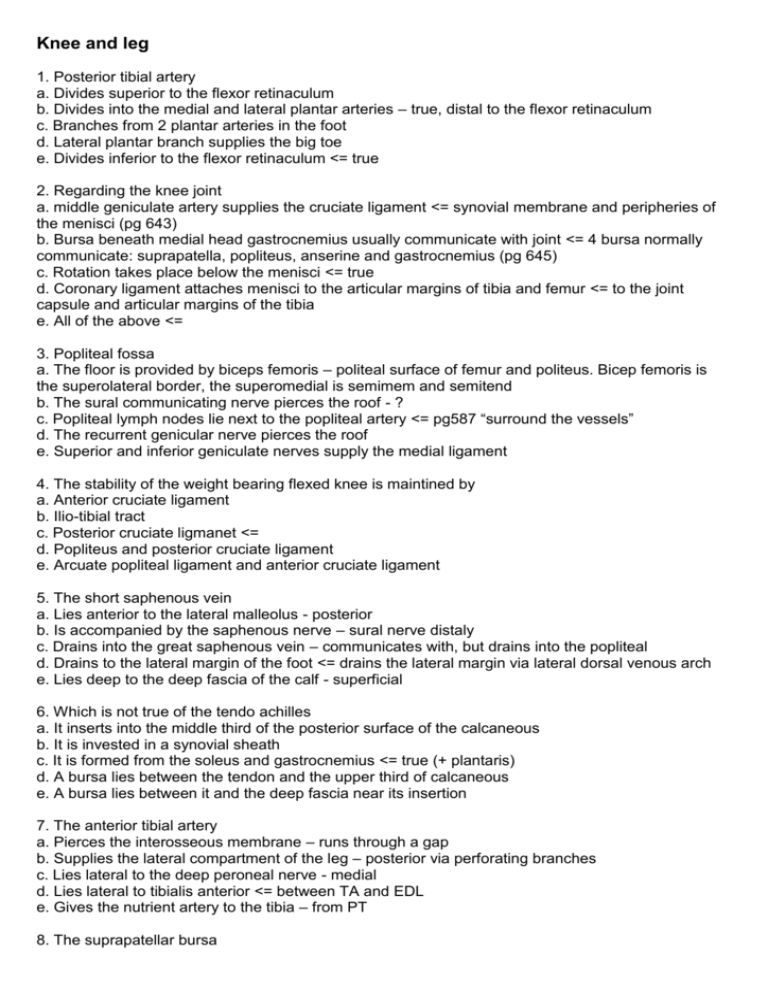
Knee and leg 1. Posterior tibial artery a. Divides superior to the flexor retinaculum b. Divides into the medial and lateral plantar arteries – true, distal to the flexor retinaculum c. Branches from 2 plantar arteries in the foot d. Lateral plantar branch supplies the big toe e. Divides inferior to the flexor retinaculum <= true 2. Regarding the knee joint a. middle geniculate artery supplies the cruciate ligament <= synovial membrane and peripheries of the menisci (pg 643) b. Bursa beneath medial head gastrocnemius usually communicate with joint <= 4 bursa normally communicate: suprapatella, popliteus, anserine and gastrocnemius (pg 645) c. Rotation takes place below the menisci <= true d. Coronary ligament attaches menisci to the articular margins of tibia and femur <= to the joint capsule and articular margins of the tibia e. All of the above <= 3. Popliteal fossa a. The floor is provided by biceps femoris – politeal surface of femur and politeus. Bicep femoris is the superolateral border, the superomedial is semimem and semitend b. The sural communicating nerve pierces the roof - ? c. Popliteal lymph nodes lie next to the popliteal artery <= pg587 “surround the vessels” d. The recurrent genicular nerve pierces the roof e. Superior and inferior geniculate nerves supply the medial ligament 4. The stability of the weight bearing flexed knee is maintined by a. Anterior cruciate ligament b. Ilio-tibial tract c. Posterior cruciate ligmanet <= d. Popliteus and posterior cruciate ligament e. Arcuate popliteal ligament and anterior cruciate ligament 5. The short saphenous vein a. Lies anterior to the lateral malleolus - posterior b. Is accompanied by the saphenous nerve – sural nerve distaly c. Drains into the great saphenous vein – communicates with, but drains into the popliteal d. Drains to the lateral margin of the foot <= drains the lateral margin via lateral dorsal venous arch e. Lies deep to the deep fascia of the calf - superficial 6. Which is not true of the tendo achilles a. It inserts into the middle third of the posterior surface of the calcaneous b. It is invested in a synovial sheath c. It is formed from the soleus and gastrocnemius <= true (+ plantaris) d. A bursa lies between the tendon and the upper third of calcaneous e. A bursa lies between it and the deep fascia near its insertion 7. The anterior tibial artery a. Pierces the interosseous membrane – runs through a gap b. Supplies the lateral compartment of the leg – posterior via perforating branches c. Lies lateral to the deep peroneal nerve - medial d. Lies lateral to tibialis anterior <= between TA and EDL e. Gives the nutrient artery to the tibia – from PT 8. The suprapatellar bursa a. Does not communicate with the knee joint b. Lies in front of the vastus intermedius muscle c. Extends 5cm or more above the patella <= this is true? d. Lies deep to the patella retinacula – superior to? e. None of the above 9. Regarding the extensor compartment of the lower leg, all of the following statements are true, except a. The tibialis anterior muscle is supplied by the deep peroneal and recurrent genicular nerves (L4) b. Extensor digitorum longus and peroneus tertius muscle lie lateral to the tibialis anterial artery throughout c. The deep peroneal nerve arises within the peroneus longus muscle d. The extensor digitorum longus dorsiflexes the lateral toes e. The extensor hallucis longus arises from the middle two-fourths of the tibia and adjacent interosseous membrane 10. Regarding lower leg structures a. The anterior tibial artery lies lateral to tibialis anterior <= b. The deep peroneal nerve originates in the popliteal fossa c. Peroneus longus is supplied by the deep peroneal nerve d. Extensor digistorum longus lies medial to tibialis anterior e. The tibia receives a nutrient vessel from the anterior tibial – PT 11. Tibialis anterior inserts into a. Navicular b. Medial cuneiform and base of first metatarsal <= c. Lateral cuneiform and base of 5th metatarsal d. Middle three metatarsals e. Medial cuneiform and base of 1st phalanx 12. Tibialis posterior inserts into a. The base of the first metatarsal b. The navicular <= c. Base of 2nd and third metatarsals <= and 4th and sustentaculum tali of calcaneus d. The cuboid <= e. None of the above 13. Factors that stabilise the patella include all except a. Forward prominence of the lateral condyle b. Forward prominence of the medial condyle <= c. Medial patellar retinacular fibres d. Vastus medialis fibres that insert into the lowest part of the patella e. The tone in vastus medialis 14. Popliteus muscle a. Is a weak flexor of the knee <= b. Is intracapsular – between the fibrous layer and synovial membrane nb the mensci are the only intrasynovial structures 15. Regarding the menisci of the knee joint a. Posterior cruciate is medial <= b. Medial meniscus is avascular – poor medial supply c. Fold of synovium lies posterior to anterior cruciate – anterior to d. Anterior horn of medial meniscus is attached to medial tibial condyle – anterior intercondylar area, but is generally attached more than the lateral meniscus 16. Which ligament forms part of the knee capsule a. Lateral collateral b. Medial collateral <= intrinsic capsular ligament pg 636 c. Anterior cruciate d. Posterior cruciate e. Popliteus tendon 17. With regard to peroneus longus muscle a. The tendon lies below peroneus brevis in the lateral compartment of the leg – superficial to b. It is supplied by the superficial peroneal nerve (L5, S1) <= L5 S1 and S2 c. Arises from the lower 2/3 s of the peroneal surface of fibula - upper d. The action is to invert the foot - evert e. It has a broad tendon in comparison to the narrower tendon of peroneus brevis - ? 18. Tibialis anterior a. Everts the foot b. Is supplied by the superficial peroneal nerve c. Arises from the lower 2/3s of the tibia and interosseous membrane d. Lies medial to the anterior tibial artery <= e. Lies lateral to peroneus tertius 19. Of muscles and tendons crossing the knee a. Popliteus medially rotates the femur to unlock the knee from extension - laterally b. Soleus crosses the posterolateral aspect of the joint – doesn’t cross the knee c. Semitendinosis tendon passes anterior to the medial condyle - post d. Gluteus maximus crosses the knee joint by way of the iliotibial tract <= e. Biceps femoris inserts into the anterolateral aspect of the tibia - anteropost 20. Regarding innervation of flexion/extension of the knee a. All muscles of the quadriceps femoris are supplied by L3/4 <= via femoral nerve b. Vastus medialis are intermedius are supplied by the same branch of the femoral nerve c. Flexion of the knee by hamstrings is supplied solely by tibial component of sciatic nerve – short head of biceps is the common fibular division d. Flexor innervation of the knee can be tested by knee jerk L3 e. Traumatic fracture dislocation of hip affects knee extension greater than flexion 21. Tibialis anterior a. Is supplied by the superficial peroneal nerve b. Has a synovial sheath that continues below superior extensor retinaculum <= c. Dorsiflexes and everts the foot – and inverts d. Inserts into the lateral cuneiform – medial and base of 1st MT e. Originates from the tibia and fibula – tibia and IO membrane 22. With regard to the stability of the knee joint a. The posterior cruciate ligament prevents the femur from slipping posteriorly on the tibia b. The lateral collateral ligament is more prone to damage than the medial c. The medial meniscus is more prone to damage than the lateral <= d. The integrity of the anterior cruciate ligament is most important when walking down stairs e. The fit of the articular surfaces of the tibia and femur is the most important factor in providing stability to the knee 23. The ligament important in producing the screw home position in full extension of the knee is the a. Anterior cruciate ligament <= b. Posterior cruciate ligament c. Arcuate popliteal ligament d. Patellar retinacula e. All of the above 24. The cruciate ligaments would be anaesthetized by injury to a. Femoral nerve b. Common peroneal nerve c. Tibial nerve <= not detailed in Moores? d. Obturator nerve e. None of the above 25. The cruciate anastomsosis a. Is supplied by the inferior branch of the medial circumflex femoral artery b. Is supplied by the descending branch of the first perforating artery c. Begins at the level of the greater trochanter d. Is supplied by the transverse branch of the lateral circumflex femoral artery <= ? e. Gives blood supply to the head of the femur 26. In the popliteal fossa a. The sural nerve branches from the common peroneal nerve – tibial -> medial sural + communicating sural from CFN -> sural b. The roof is formed by biceps femoris - superolat c. The popliteal vein lies between the popliteal artery and tibial nerve <= true, nerve sup, artery deep d. The inferomedial border is soleus – heads of gastroc e. The politeal artery runs vertically – inferolaterally to inferior border of popliteus to divide 27. Politeus a. Arises from the tibia above the condyles b. Slopes upwards and medially c. Inserts into the lateral meniscus <= d. In innervated by a branch of the common peroneal nerve - deep e. Acts to “lock” the knee in full extension 28. With regards to the knee joint a. The medial collateral ligament extends 8cm below the joint margin b. The medial collateral ligament is extra-articular c. The tenson of politeus is intra-articular – ‘intracapsular’, it is outside the synovium d. The lateral meniscus is more C-shaped e. All of the above <= 29. Tibialis anterior a. Dorsiflexes and everts the foot b. Arises from the upper 2/3s of the fibula c. Inserts into the medial cuneiform <= and base of 1st MT d. Shares its site of insertion with peroneus tertius – dorsum base of 5th (is an ant com m) e. Is supplied by L5,S1 – L4,5 30. In the lateral compartment of the leg a. The muscles are supplied by the deep peroneal nerve b. The peroneus longus muscles arise only from the fibula <= c. The peroneal muscle tendons are bound at the lateral malleolus by the inferior peroneal retinaculum d. The peroneal muscles share a common synovial sheath at the lateral malleolus e. The blood supply is from the anterior tibial artery - post

